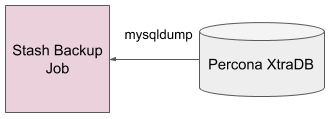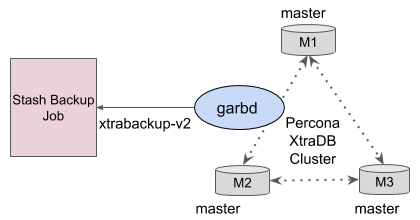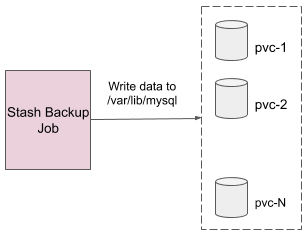You are looking at the documentation of a prior release. To read the documentation of the latest release, please
visit here.
New to KubeDB? Please start here.
Percona XtraDB Backup & Restore Overview
KubeDB uses Stash to backup and restore databases. Stash by AppsCode is a cloud native data backup and recovery solution for Kubernetes workloads. Stash utilizes restic to securely backup stateful applications to any cloud or on-prem storage backends (for example, S3, GCS, Azure Blob storage, Minio, NetApp, Dell EMC etc.).

How Backup Works
The following diagram shows how Stash takes backup of a Percona XtraDB database. Open the image in a new tab to see the enlarged version.

The backup process consists of the following steps:
At first, a user creates a secret with access credentials of the backend where the backed up data will be stored.
Then, she creates a
Repositorycrd that specifies the backend information along with the secret that holds the credentials to access the backend.Then, she creates a
BackupConfigurationcrd targeting the AppBinding crd of the desired database. TheBackupConfigurationobject also specifies theTaskto use to backup the database.Stash operator watches for
BackupConfigurationcrd.Once Stash operator finds a
BackupConfigurationcrd, it creates a CronJob with the schedule specified inBackupConfigurationobject to trigger backup periodically.On the next scheduled slot, the CronJob triggers a backup by creating a
BackupSessioncrd.Stash operator also watches for
BackupSessioncrd.When it finds a
BackupSessionobject, it resolves the respectiveTaskandFunctionand prepares a Job definition to backup.Then, it creates the Job to backup the targeted database.
The backup Job reads necessary information to connect with the database from the
AppBindingcrd. It also reads backend information and access credentials fromRepositorycrd and Storage Secret respectively.Then, the Job dumps the targeted database(s) and uploads the output to the backend. Stash pipes the output of the dump command to the upload process. Hence, backup Job does not require a large volume to hold the entire dump output.
Finally, when the backup is complete, the Job sends Prometheus metrics to the Pushgateway running inside Stash operator pod. It also updates the
BackupSessionandRepositorystatus to reflect the backup procedure.
Backup Different Percona XtraDB Configurations
This section will show you how backup works for different Percona XtraDB Configurations.
Standalone Percona XtraDB
For a standalone Percona XtraDB database, the backup job directly dumps the database using mysqldump and pipe the output to the backup process.

Percona XtraDB Cluster
For a standalone Percona XtraDB database, the backup Job runs the backup procedure to take the backup of the targeted databases and uploads the output to the backend. In backup procedure, the Job runs a process called garbd (Galera Arbitrator) which uses xtrabackup-v2 script during State Snapshot Transfer (SST). Basically this Job takes a full copy of the data stored in the data directory (/var/lib/mysql) and pipes the output of the backup procedure to the uploading process. Hence, backup Job does not require a large volume to hold the entire backed up data.

How Restore Process Works
The following diagram shows how Stash restores backed up data into a Percona XtraDB database. Open the image in a new tab to see the enlarged version.

The restore process consists of the following steps:
At first, a user creates a
RestoreSessioncrd targeting theAppBindingof the desired database where the backed up data will be restored. It also specifies theRepositorycrd which holds the backend information and theTaskto use to restore the target.Stash operator watches for
RestoreSessionobject.Once it finds a
RestoreSessionobject, it resolves the respectiveTaskandFunctionand prepares a Job (in case of restoring cluster more than one Job and PVC) definition(s) to restore.Then, it creates the Job(s) (as well as PVCs in case of cluster) to restore the target.
The Job(s) reads necessary information to connect with the database from respective
AppBindingcrd. It also reads backend information and access credentials fromRepositorycrd and Storage Secret respectively.Then, the Job(s) downloads the backed up data from the backend and injects into the desired database. Stash pipes the downloaded data to inject into the database. Hence, the restore Job(s) does not require a large volume to download entire backup data inside it.
Finally, when the restore process is complete, the Job(s) sends Prometheus metrics to the Pushgateway and update the
RestoreSessionstatus to reflect restore completion.
Restore Different Percona XtraDB Configurations
This section will show you how restore works for different Percona XtraDB Configurations.
Standalone Percona XtraDB
For a standalone Percona XtraDB database, the restore Job downloads the backed up data from the backend and pipe the downloaded data to mysql command which inserts the data into the desired database.

Percona XtraDB Cluster
For a Percona XtraDB Cluster, the Stash operator creates a number (equal to the value of .spec.target.replicas of RestoreSession object) of Jobs to restore. Each of these Jobs requires a PVC to store the previously backed up data of the data directory /var/lib/mysql from the backend. Then each Job downloads the backed up data from the backend and injects into the associated PVC.































